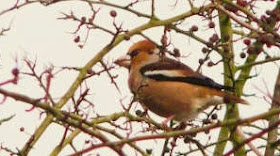This bird is more of a hunch, it certainly isn't 95% guaranteed like the Woodlark. In only one winter out of 12 have we had a good connection with this species in the wild, and I seem to remember it was just the Tuesday and Wednesday afternoons which did so. This was way back in 2009, and it's possible that the conditions which made sightings possible then, will be repeated this winter.
Hawfinch (c) 2009 Marcus Conway
Hawfinch after ringing at Spurn
This year in East Yorkshire there has been a catastrophic failure of the beech mast crop, which is going to have an effect on the birds which we encounter in the coming term. For instance, Bramblings arrived on the coast as normal in the winter, but when they checked out the beech mast under the trees at Nunburnholme they found that there wasn't any, and for the first time in 5 years they had to move on elsewhere. Beech mast isn't only important for Bramblings, but is a staple food in the winter for common resident birds like Great Tits and Chaffinches, but also the much rarer Hawfinch. When the beech mast crop fails the Hawfinch obviously has to turn to another food source, so was this why 2 individuals were consuming hawthorn berries in the sunshine back in January 2009?
Hawfinch (c) 2009 Chris Cox
Last time it was very difficult to get perfect, sharp, close photos of Hawfinches, as several of these pictures show, so if we do see them in 2016, I'm hoping now that there are more photographers on the classes, we will get some more striking photographs.
Record shot of Hawfinch (c) 2009 Chris Gomersall
Record shot of Hawfinch (c) 2009 Tony Robinson
I have vague memories of seeing a Hawfinch feeding among Chaffinches near Walkington when I was a child, but my first adult experiences were a little strange. In the early 1980s I spent a lot of time cycling the region making recordings of birdsong. On listening back to those I realised I'd managed to record Hawfinches making their strange Robin-like ticking sounds at either Allerthorpe Common or Millington Wood. Even more unusually, on the morning of 12th April 1998 there was a loud bang on the kitchen window, and half an hour later we found the head of a Hawfinch with metallic silvery-grey beak attached, but all feathers removed. It's possible that a Sparrowhawk caught the bird feeding on our nearby Hornbeam, and plucked the feathers from the head before casting it aside, and it happened to strike our window. Since that time I've seen a couple of individuals after they were ringed at Spurn, but the Millington birds were the most confiding individuals in the wild.
Record shot of Hawfinch (c) 2009 John Batham
Hawfinches are the largest UK finch by far, and have a very attractive plumage. Their basic colour is a orangey-brown with a grey nape and a brown back, but they are also adorned with large areas of white on their dark wings and the tip of the tail. They have a small black bib, and in adult
plumage black around the eye. The bill only attains the silvery-grey hue when it is in breeding condition - the birds we saw in winter had a pinkish, less impressive bill. However there is nothing unimpressive about the size of the bill. This is extremely large for the size of bird, and is the only bill powerful enough to exert enough pressure to crack a cherry stone.
Hawfinch after ringing at Spurn - note wing markings
Record shot of Hawfinch after being ringed at Spurn
Although the winter schedule was drawn up many months ago, and as these birds have been seen by relatively few current class members, if I hear of a reliable location for Hawfinches we will drop the venue we were supposed to be visiting to attempt to have decent views of these enormous, striking finches!









No comments:
Post a Comment